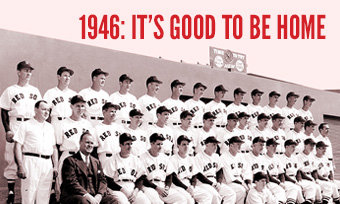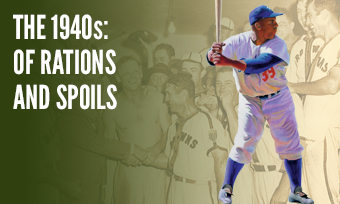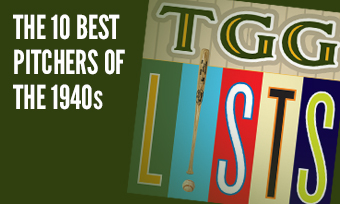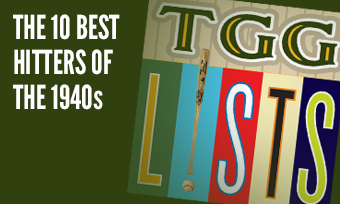The Yearly Reader
Leaders and Honors, 1946
Our list of baseball’s top 10 hitters and pitchers in both the American League and National League for the 1946 baseball season, as well as the awards and honors given to the game’s top achievers of the year.
The National League’s Top 10 Hitters, 1946
Bold type in brick red indicates league leader.
1. Stan Musial, St. Louis
Key Numbers: 156 games, .365 average, 624 at-bats, 124 runs, 228 hits, 50 doubles, 20 triples, 16 home runs, 103 RBIs, 73 walks, .587 slugging percentage.
For now, home runs were a luxury for Musial; he led the NL in singles, doubles and triples.
2. Enos Slaughter, St. Louis
Key Numbers: 156 games, .300 average, 100 runs, 183 hits, 30 doubles, 8 triples, 18 home runs, 130 RBIs, 69 walks.
Slaughter’s famed “mad dash” in the World Series wasn’t the only time he created anxieties for opponents; he led the NL in reaching base on error (16), which could be read as a measure of fielders feeling more rushed to make a play.
3. Dixie Walker, Brooklyn
Key Numbers: .319 average, 80 runs, 184 hits, 29 doubles, 9 triples, 9 home runs, 116 RBIs, 67 walks, 19 intentional walks, 14 stolen bases.
In the year before Jackie Robinson disrupted his Southern-bred comfort zone, Walker was hitting as high as .382 in early August before slumping down the stretch, possibly costing the Dodgers a pennant in the process. It was also the second straight year he knocked in well over 100 runs on less than 10 home runs.
4. Johnny Mize, New York
Key Numbers: 101 games, .337 average, 70 runs, 22 home runs, 70 RBIs, 62 walks.
A broken hand suffered in a midseason exhibition game against the Yankees shortened a potential MVP season; without him in the lineup, the Giants went 15-42 and finished last for the first time in a non-wartime season since 1915.
5. Whitey Kurowski, St. Louis
Key Numbers: .301 average, 32 doubles, 5 triples, 14 home runs, 89 RBIs, 72 walks.
The third baseman showed he was no wartime fluke by maintaining his level of play against superior competition.
6. Phil Cavarretta, Chicago
Key Numbers: 139 games, .294 average, 89 runs, 28 doubles, 10 triples, 8 home runs, 78 RBIs, 88 walks.
His career having peaked during the war, Cavarretta continued to put up solid numbers as he hit age 30.
7. Pete Reiser, Brooklyn
Key Numbers: 127 games, .277 average, 75 runs, 21 doubles, 5 triples, 11 home runs, 73 RBIs, 34 stolen bases.
After three years serving in the Army, Reiser resumed his hazardous baseball life in the outfield trenches and, for the most part, survived without major injury.
8. Del Ennis, Philadelphia
Key Numbers: .313 average, 30 doubles, 6 triples, 17 home runs, 73 RBIs.
A year before the Baseball Writers’ Association of America began picking the Rookie of the Year, The Sporting News initiated their own first-year honor by selecting the 21-year-old Ennis, who hit a career-high .313.
9. Tommy Holmes, Boston
Key Numbers: .310 average, 80 runs, 176 hits, 35 doubles, 6 triples, 6 home runs, 79 RBIs.
The reigning NL MVP hit well with the star players back, but his home run production shriveled from 28 to a mere six—including just two at Braves Field.
10. Johnny Hopp, Boston
Key Numbers: 129 games, .333 average, 23 doubles, 8 triples, 21 stolen bases.
Traded to the Braves to make room for Enos Slaughter and Stan Musial back in St. Louis, Hopp ran his average up to .380 by mid-summer before, like Dixie Walker above, slumping late.
The American League’s Top 10 Hitters, 1946
1. Ted Williams, Boston
Key Numbers: .342 average, 142 runs, 176 hits, 37 doubles, 8 triples, 38 home runs, 123 RBIs, 156 walks, 29 intentional walks, .497 on-base percentage, .667 slugging percentage.
Williams overcame desperate defensive shifts and contentious voters to pick up his first (and long overdue) MVP—and he still barely edged out the #2, Detroit pitcher Hal Newhouser.
2. Hank Greenberg, Detroit
Key Numbers: .277 average, 91 runs, 29 doubles, 5 triples, 44 home runs, 127 RBIs, 80 walks.
In his last year at Detroit, Greenberg paced the majors in homers—but also became the first AL player to park 40 over the fence while hitting under .300.
3. Charlie Keller, New York
Key Numbers: .275 average, 98 runs, 29 doubles, 10 triples, 30 home runs, 101 RBIs, 113 walks, 101 strikeouts.
Keller cleared the triple-double—at least 10 doubles, triples and homers each—while surpassing 100 in RBIs, walks and strikeouts.
4. Mickey Vernon, Washington
Key Numbers: .353 average, 88 runs, 207 hits, 51 doubles, 8 triples, 8 home runs, 85 RBIs, 14 stolen bases.
Vernon never got to .300 during the 1940s—except in 1946 with an eye-popping burst of hitting that won him the AL batting title.
5. Joe DiMaggio, New York
Key Numbers: 132 games, .290 average, 81 runs, 20 doubles, 8 triples, 25 home runs, 95 RBIs.
A muted return to major league life for Joltin’ Joe, who struggled with a slow start and injuries before becoming the familiar DiMaggio of old late in the year; he finished below the .300 mark for only one of two times in his career.
6. Bobby Doerr, Boston
Key Numbers: .271 average, 95 runs, 34 doubles, 9 triples, 18 home runs, 116 RBIs, 66 walks.
Doerr happily reclaimed his pre-war role as Ted Williams’ faithful sidekick in Boston.
7. Rudy York, Boston
Key Numbers: .276 average, 78 runs, 160 hits, 30 doubles, 6 triples, 17 home runs, 119 RBIs, 86 walks.
Ten of York’s 119 RBIs came in one game—making him the only American Leaguer to knock in at least 10 during a 1940s contest.
8. Johnny Pesky, Boston
Key Numbers: .335 average, 621 at-bats, 115 runs, 208 hits, 43 doubles, 65 walks.
In his second major league season—four years after his first—Pesky put up a virtual carbon copy of his set of rookie numbers.
9. Stan Spence, Washington
Key Numbers: .292 average, 83 runs, 169 hits, 50 doubles, 10 triples, 16 home runs, 87 RBIs, 62 walks.
Spence continued to be the Senators’ version of a slugger, though only two of his 16 homers came at Griffith Stadium; he would be the only member of the team from 1942-48 to clear 10 in any year.
10. Jeff Heath, Washington-St. Louis
Key Numbers: 134 games, .278 average, 32 doubles, 7 triples, 16 home runs, 84 RBIs, 73 walks.
The veteran outfielder might have joined Spence in Washington’s double-digit club had he played out the entire season there; he had four homers in 48 games for the Senators before his trade to the Browns.
The National League’s Top 10 Pitchers, 1946
1. Johnny Sain, Boston
Key Numbers: 2.21 ERA, 20 wins, 14 losses, 37 appearances, 34 starts, 24 complete games, 265 innings.
Sain, who would tutor a bunch of future pitchers into 20-game winners, was his own first student.
2. Howie Pollet, St. Louis
Key Numbers: 2.10 ERA, 21 wins, 10 losses, .677 win percentage, 5 saves, 40 appearances, 32 starts, 22 complete games, 266 innings.
When last seen on the mound, Pollet was on his way to the 1943 NL ERA crown—before the military grabbed him; three years later, he got to finish the job.
3. Harry Brecheen, St. Louis
Key Numbers: 2.49 ERA, 15 wins, 15 losses, 36 appearances, 30 starts, 5 shutouts, 231.1 innings.
The wins came much harder for Brecheen, all because the Cardinals—who led the NL in runs scored—tallied no more than twice in 10 of his losses.
4. Johnny Schmitz, Chicago
Key Numbers: 2.61 ERA, 11 wins, 11 losses, 41 appearances, 31 starts, 224.1 innings, 135 strikeouts.
His younger years on the diamond canceled out by the war, Schmitz made for an impressive first full year and led the NL in strikeouts—though Bob Feller, his AL counterpart passed up his eventual season total on June 12.
5. Murry Dickson, St. Louis
Key Numbers: 2.88 ERA, 15 wins, 6 losses, .714 win percentage, 47 appearances, 19 starts.
The future hard-luck loser for the Pirates enjoyed a rare taste of the winning life, easily posting his highest win percentage of his career.
6. Ewell Blackwell, Cincinnati
Key Numbers: 2.45 ERA, 9 wins, 13 losses, 33 appearances, 25 starts, 5 shutouts, 194.1 innings.
And talk about hard luck; the 23-year-old rookie had to scratch and claw for his precious few wins, with five of them by shutout.
7. Kirby Higbe, Brooklyn
Key Numbers: 3.03 ERA, 17 wins, 8 losses, .680 win percentage, 42 appearances, 29 starts, 210.2 innings, 107 walks, 6 wild pitches.
After a two-year layoff, rust wasn’t much of a factor for the veteran right-hander as he didn’t lose his first game until July 5.
8. Schoolboy Rowe, Philadelphia
Key Numbers: 2.12 ERA, 11 wins, 4 losses, 16 starts, 136 innings, 21 walks.
A groin injury prematurely spelled an end to a terrific comeback effort for the 36-year old, missing the season’s final two months.
9. Hank Wyse, Chicago
Key Numbers: 2.68 ERA, 14 wins, 12 losses, 40 appearances, 27 starts, 201.1 innings, 52 walks.
The 22-game winner of a year earlier posted the same exact ERA but collected eight less victories.
10. Fritz Ostermueller, Pittsburgh
Key Numbers: 2.84 ERA, 13 wins, 10 losses, 25 starts, 193.1 innings.
Likely relieved for a different reason that war was over, the guy with a very German name did his best to salvage a poor Pirates ballclub at age 38.
The American League’s Top 10 Pitchers, 1946
1. Hal Newhouser, Detroit
Key Numbers: 1.94 ERA, 26 wins, 9 losses, .743 win percentage, 37 appearances, 34 starts, 29 complete games, 292.2 innings, 275 strikeouts.
Newhouser proved that his wartime stats were no fluke and neutralized the best of the best—with only Williams getting in his way of an unprecedented third straight MVP.
2. Bob Feller, Cleveland
Key Numbers: 2.18 ERA, 26 wins, 15 losses, 4 saves, 48 appearances, 42 starts, 36 complete games, 10 shutouts, 371.1 innings, 153 walks, 348 strikeouts.
Feller’s 36 complete games were the most since the deadball era; his 348 strikeouts were thought to be one more than Rube Waddell’s 1904 record, until historians later ramped Waddell back ahead by one. Besides throwing his second career no-hitter, Feller also tossed two one-hitters.
3. Spud Chandler, New York
Key Numbers: 2.10 ERA, 20 wins, 8 losses, 32 starts, 257.1 innings, 36 grounded into double plays.
Amid a year very comparable to his stifling 1943 campaign, Chandler won his final three starts—two by shutout—to clinch his second career 20-win ledger.
4. Tex Hughson, Boston
Key Numbers: 2.75 ERA, 20 wins, 11 losses, 39 appearances, 35 starts, 278 innings, 51 walks.
Echoing Chandler, Hughson also won his last three starts to compile his second 20-win record.
5. Bill Bevens, New York
Key Numbers: 2.23 ERA, 16 wins, 13 losses, 31 starts, 249.2 innings.
Bevens’ brief and wild career peaked mostly because he kept his control in check.
6. Dizzy Trout, Detroit
Key Numbers: 2.34 ERA, 17 wins, 13 losses, 38 appearances, 32 starts, 23 complete games, 5 shutouts, 276.1 innings, 30 grounded into double plays.
After sticking around through the war, Trout skipped nary a beat against enhanced postwar competition.
7. Boo Ferriss, Boston
Key Numbers: 3.25 ERA, 25 wins, 6 losses, .806 win percentage, 40 appearances 35 starts, 26 complete games, 274 innings.
Boo didn’t scare a lot of opponents as, despite that record and ERA, he led the AL in runs allowed; it didn’t hurt that the Red Sox gave him over six runs of support per start.
8. Bobo Newsom, Philadelphia-Washington
Key Numbers: 2.93 ERA, 14 wins, 13 losses, 34 appearances, 31 starts, 236.2 innings, 7 hit-by-pitches.
Baseball’s ultimate transient of the day, Newsom not surprisingly switched addresses once again during the year; it would be his fourth trade to Washington. A fifth D.C. tenure lay ahead in 1952.
9. Jesse Flores, Philadelphia
Key Numbers: 2.32 ERA, 9 wins, 7 losses, 29 appearances, 15 starts, 155 innings, 38 walks.
The otherwise common Flores posted a 7-3 record and 1.58 ERA over the season’s final two months, giving brief life to a lifeless (49-105) A’s team.
10. Ed Lopat, Chicago
Key Numbers: 2.73 ERA, 13 wins, 13 losses, 29 starts, 231 innings, 48 walks.
The southpaw had to win his final two starts to finish with a .500 mark; he wouldn’t sweat out the possibility of a losing record again until 1955.









